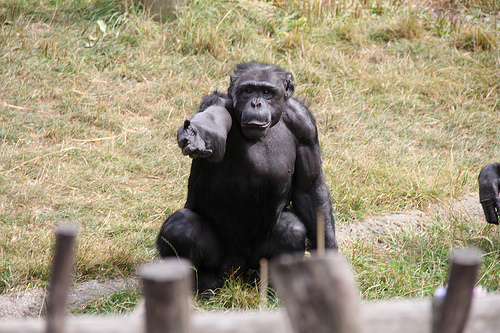
Ape and human infants at comparable stages of development use similar gestures, such as pointing or lifting their arms to be picked up, new research suggests.
Chimpanzee, bonobo and human babies rely mainly on gestures at about a year old, and gradually develop symbolic language (words, for human babies; and signs, for apes) as they get older.
The findings suggest that “gesture plays an important role in the evolution of language, because it preceded language use across the species," said study co-author Kristen Gillespie-Lynch, a developmental psychologist at the College of Staten Island in New York.
The gesturing behavior was described today (June 6) in the journal Frontiers in Comparative Psychology. [8 Humanlike Behaviors of Primates]
Language precursor
The idea that language arose from gesture and a primitive sign language has a long history. French philosopher Étienne Bonnot de Condillac proposed the idea in 1746, and other scientists have noted that walking on two legs, which frees up the hands for gesturing, occurred earlier in human evolution than changes to the vocal tract that enabled speaking.
But although apes in captivity can learn some language by learning from humans, in the wild, they don't gesture nearly as much as human infants, making it difficult to tease out commonalities in language development that have biological versus environmental roots.
Get the world’s most fascinating discoveries delivered straight to your inbox.
To do so, Gillespie-Lynch and her colleagues compared detailed video of an American baby girl in everyday life with two apes of the same age that were trained to communicate. Panpanzee, a chimpanzee, and Panbanisha, a bonobo, were living at the Language Research Center in Atlanta, where they received interactive training in sign language, gesturing and vocalizations; they also went through a daily testing session.
The researchers analyzed the young apes’ behavior when they were about a year old to about 26 months old to that of the human baby when she was 11 months old to almost 2 years old.
Common language
Both the apes and the human baby started out gesturing more than using words, and they used similar gestures, such as pointing at or reaching for things they wanted, or lifting their arms when they wanted to be picked up.
“The 'up' gesture looks just like if you find a human child asking to pick them up," Gillespie-Lynch told LiveScience.
The baby girl used more gestures overall and developed gestures — such as waving bye-bye, shaking the head and nodding — that the apes did not demonstrate.
The girl tended to use more gestures for showing things to caretakers, whereas the apes relied more on reaching gestures. Together, the findings suggest the human child was more focused on sharing her experience with others, whereas the apes were using gestures more instrumentally to get what they wanted.
As they grew older, the species' trajectories diverged. All the infants gradually shifted to using more symbolic words, but the child's shift was much more dramatic than the apes'. And from the start, the little girl vocalized more than the apes did.
Because gesture played an early role in communication in all of the babies, it probably also played a similar role in a common ancestor, Gillespie-Lynch noted.
"So we're getting an idea of what our common ancestor was like in terms of how that ancestor might have been able to communicate," she said.
Follow Tia Ghose on Twitterand Google+. Follow LiveScience @livescience, Facebook & Google+. Original article on LiveScience.com.

Tia is the editor-in-chief (premium) and was formerly managing editor and senior writer for Live Science. Her work has appeared in Scientific American, Wired.com, Science News and other outlets. She holds a master's degree in bioengineering from the University of Washington, a graduate certificate in science writing from UC Santa Cruz and a bachelor's degree in mechanical engineering from the University of Texas at Austin. Tia was part of a team at the Milwaukee Journal Sentinel that published the Empty Cradles series on preterm births, which won multiple awards, including the 2012 Casey Medal for Meritorious Journalism.



